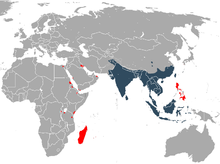Asian house shrew
The Asian house shrew (Suncus murinus) is a type of shrew. It is native to South and Southeast Asia. It is the largest type of shrew. It is a least concern species. It has been introduced in several West Asian and East African countries.[3] It is an invasive species.[4]
| Asian House Shrew | |
|---|---|

| |
| Scientific classification | |
| Domain: | Eukaryota |
| Kingdom: | Animalia |
| Phylum: | Chordata |
| Class: | Mammalia |
| Order: | Eulipotyphla |
| Family: | Soricidae |
| Genus: | Suncus |
| Species: | S. murinus[1]
|
| Binomial name | |
| Suncus murinus[1] | |

| |
| Asian house shrew range (blue — native, red — introduced) | |
| Synonyms | |
|
Sorex murinus Linnaeus, 1766 | |
Description
changeThe Asian house shrew is 100 mm and 150 mm long. An adult female weighs between 23.5 g and 82.0 g. An adult male weighs from 33.2 g to 147.3 g.[5] It has short, dense fur. It is mid-grey to brownish-grey color.[6]
Distribution and Habitat
changeThe Asian house shrew is native to South and Southeast Asia. It was introduced to eastern Africa, Arabia, Madagascar, the Philippines and other islands in the Indian and Pacific Oceans.[3]
It is found in forests, agricultural lands, and in places with lots of human activity. It is also found in many houses and businesses. It is mainly a terrestrial animal.[5]
Feeding
changeIt is mainly an insectivore. It eats insects, mammals, plants and human food.[5]
Behaviour
changeIt very adaptable species. They are nocturnal. They are thought to mainly live by themselves.[5]
Reproduction
changeThey breed throughout the year. It gives birth to one to eight young ones. The gestation period is one month. It starts breeding when it is around one year old.[7]
Relationships with humans
changeIt helps to control the population of many pests. It is an invasive species. They compete with many types of plants and animals. It is also a pest. It can damage food and other materials found in homes and businesses.[5]
References
change- ↑ Hutterer, Rainer (2005). Don E. Wilson; DeeAnn M. Reeder (eds.). Mammal Species of the World (3rd ed.). Johns Hopkins University Press. pp. 260–261. ISBN 978-0-8018-8221-0.
- ↑ Hutterer, R.; Molur, S. & Heaney, L. (2016). "Suncus murinus". IUCN Red List of Threatened Species. 2016: e.T41440A22287830.
- ↑ 3.0 3.1 Hutterer, R. (2016-02-01). "IUCN Red List of Threatened Species: Suncus murinus". IUCN Red List of Threatened Species. Retrieved 2020-09-22.
- ↑ "GISD". www.iucngisd.org. Retrieved 2020-09-22.
- ↑ 5.0 5.1 5.2 5.3 5.4 Lench, Jessica. "Suncus murinus (Asian house shrew)". Animal Diversity Web. Retrieved 2020-09-22.
- ↑ Louch, Charles D.; Ghosh, Ajoy Kumar; Pal, Bikash C. (1966). "Seasonal Changes in Weight and Reproductive Activity of Suncus murinus in West Bengal, India". Journal of Mammalogy. 47 (1): 73–78. doi:10.2307/1378070. JSTOR 1378070. PMID 5905563.
- ↑ Temple, J. L. (2004-01-01). "The Musk Shrew (Suncus murinus): A Model Species for Studies of Nutritional Regulation of Reproduction". ILAR Journal. 45 (1): 25–34. doi:10.1093/ilar.45.1.25. ISSN 1084-2020. PMID 14752205.
